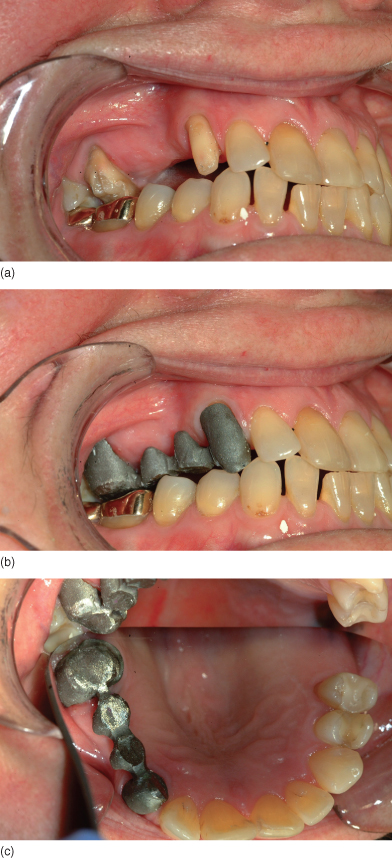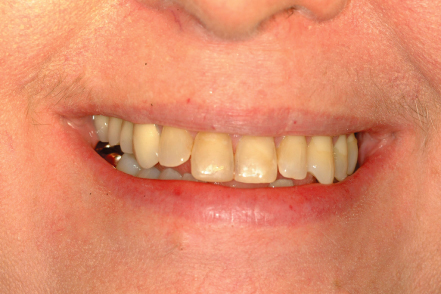Chapter 8
You’ve Changed My Bite
History
Mrs Smith is a 40-year-old teacher and is a new patient to your practice. You already treat her husband and her two children. She attends complaining of pain over the right side of her face in front of her ear, headache and a feeling of restricted jaw movement.
Mrs Smith was a regular attender at another practice close to you. She had no problems until 2 months ago when she started to experience facial pain after she had a bridge fitted to replace a missing upper right first and second premolar teeth. She had this bridge placed for aesthetic reasons only. She had had the teeth taken out 2 years ago after an abscess and a failed root canal treatment and her husband had suggested that she should have the gap filled to improve her smile.
Mrs Smith is very dentally aware and readily agreed to have the treatment done. The teeth on either side of the gap had large amalgams and she was conscious of the appearance of these in any case so she felt that this would be a good idea, not only to fill the gap, but also to eliminate the appearance of unsightly restorations. The teeth on either side of the gap had been prepared uneventfully and temporary crowns had been placed but at various times both had fallen off. She phoned the practice but was told that, as the teeth were only mildly sensitive and the dentist was really busy, she should just wait until the permanent bridge was ready in a couple of weeks. At this stage she was not aware of any change in her bite.
She returned for provision of the permanent bridge and this again proceeded uneventfully. She had this done under a local anaesthetic. Following the provision of the bridge she felt that her ‘bite felt different’ and she returned to the dentist 3 days later (Figures 8.1 and 8.2).
Figure 8.1 (a) Prepared bridge abutments and (b and c) heavily adjusted framework in place.

Figure 8.2 Fitted bridge: note the gap between upper and lower right lateral incisors compared with Figure 8.1a/b.


By this stage she had developed right sided facial pain.

She said that the bridge was very sensitive to bite on and the teeth were reacting to hot and cold stimulus. However her main complaint was that her bite felt altered. She was happy with the aesthetics of the completed restoration and to avoid any alteration to this the dentist suggested that it would be easier to adjust the bite by removing some tissue from her lower teeth opposing the bridge. The dentist did this but within a couple of days Mrs Smith was aware of the fact that her lower teeth had also become sensitive and the symptoms from the upper bridge remained unaltered. She said it was difficult to differentiate between the sensitivity she was experiencing from the bridge and from the lower teeth but she was sure that the hypersensitivity was not restricted to the upper arch.
Mrs Smith had returned to her dentist on two subsequent occasions and on one of these further occlusal adjustments were made, again to the lower teeth.

As the symptoms were worsening rather than improving, Mrs Smith asked her husband to book an appointment with you for a second opinion. She has decided to leave her previous practice and come to you. She commented that she felt aggrieved and she was contemplating litigation and asked for your support. She had had the bridge fitted privately and she said it ‘cost an arm and a leg’. On questioning her about her medical history she said that she had been suffering from depression and was worried about ‘my appearance now I have hit 40!’. She is now on an antidepressant (citalopram). She was a regular dental patient and had seen her previous dentist every 6 months.
Examination
It was apparent from intraoral examination that Mrs Smith was very dentally aware. Her oral hygiene was of a very high standard, there were no plaque or calculus deposits and her BPE was one in each sextant. All the soft tissues appeared healthy.
On examination of her articulatory system, the right TMJ was tender on lateral and especially on intra-auricular palpation. Although she felt that her mouth opening was restricted, she had a normal range of movement. being able to open to 35 mm in the vertical dimension. This was, however, painful for her to do. There were no joint sounds.
On examination of the mandibular muscles, the right temporalis and masseter muscles were tender on palpation in the origin of both muscles, i.e. in the anterior temple and along the anterior two-thirds of the zygomatic arch. The right lateral pterygoid muscle was tender against resistance in the vertical dimension.
On examination of the occlusion, centric jaw rel/>
Stay updated, free dental videos. Join our Telegram channel

VIDEdental - Online dental courses


